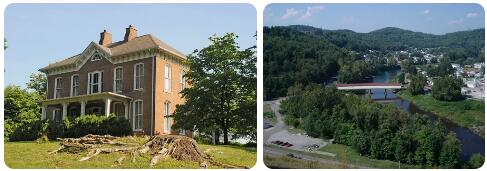
Barbour County, West Virginia is situated in the north-central part of the state and is home to a population of nearly 16,000 people. The county was established in 1843 from parts of Harrison, Lewis, and Randolph Counties and was named after Philip Pendleton Barbour, an Associate Justice of the Supreme Court.
The county has a rich history that dates back to when it was part of the western frontier during colonial times. In 1767, Lord Fairfax granted land to settlers in this area which spurred further settlement by pioneers. During the Revolutionary War, local militias fought off British attacks and helped General Washington secure victory at Valley Forge.
Barbour County has long been an important agricultural region with tobacco being one of its main crops for many years. In addition to tobacco, farmers grew corn, wheat, oats and hay as well as raising livestock such as sheep and cows. The area also became known for its timber production with sawmills located throughout the county providing lumber for building homes and other structures.
In more recent years, Barbour County has become known for its tourism industry with visitors coming from around the world to enjoy its natural beauty and outdoor recreational activities such as fishing on the Cheat River or camping at one of its many state parks or forests. The county also offers cultural attractions like museums and galleries that showcase local artisans’ work as well as historical sites like Prickett’s Fort State Park where visitors can learn about life on the western frontier during colonial times.
The county seat is Philippi which was founded in 1844 by Drue Haught who named it after his hometown in Ohio. Philippi is best known for being home to the first land battle of the Civil War which took place on May 23rd 1861 when Union forces led by General George B McClellan defeated Confederate forces led by Colonel George A Porterfield at what is now known as The Battle Of Philippi Races Historic Site & Museum.
Today, Barbour County remains an important agricultural region but has also become a popular destination for tourists looking to explore its natural beauty or experience some of its local culture and history. With a variety of attractions ranging from outdoor recreation to historical sites there’s something here for everyone who visits this beautiful corner of West Virginia.
History of Barbour County, West Virginia
Barbour County, West Virginia was formed in 1843 from parts of Harrison, Lewis, and Randolph Counties. It was named for Philip Pendleton Barbour, a US Supreme Court Justice and delegate to the Virginia Constitutional Convention. The county is located in the North-Central region of West Virginia and is bordered by Randolph County to the north, Upshur County to the east, Lewis County to the south and Harrison County to the west.
The first settlers of Barbour County arrived in 1784 from Maryland and Pennsylvania. They began farming the hilly terrain and built log cabins along the Tygart Valley River. By 1800, there were over 500 people living in Barbour County.
In 1868, Philippi became the county seat of Barbour County after a heated election between Philippi and Belington. Following this election, Philippi began to grow rapidly as new businesses opened up along Main Street. The railroad also came through town which helped spur growth even further as it allowed goods to be transported easily throughout the area.
During this time period (1870-1900), coal mining also became an important part of Barbour County’s economy with several mines opening up across the county including; Beatrice Mine near Grafton; Excelsior Mine near Philippi; Laurel Run Mine near Belington; Red Ash Mine near Junior; Smithrun Mine near Junior; and finally White Oak Mine near Grafton.
In 1902, a devastating flood struck much of West Virginia including Barbour County which caused extensive damage throughout the area. This flood caused many residents to move away from their homes or rebuild elsewhere which lead to a decrease in population for several years following this event.
The timber industry also played an important role in Barbour County’s economy during this time with several saw mills being built throughout the region including one at Sago (now called Arden). This saw mill provided much needed jobs for many residents who worked tirelessly cutting down trees and transporting them via river or railroads back into town where they were sold for lumber or other wood products.
Barbour County continued to grow throughout much of the 20th century with more businesses opening up along Main Street in Philippi as well as other small towns around it such as Belington and Junior which both had their own downtown areas with shops that catered mainly towards farmers in need of supplies or services related to their farms. In recent years tourism has become more prevalent throughout much of West Virginia including Barbour County due its proximity to nature such as rivers, streams, forests etc., making it an attractive destination for outdoors enthusiasts looking for some adventure while on vacation or just passing through on their way somewhere else within West Virginia or beyond its borders.